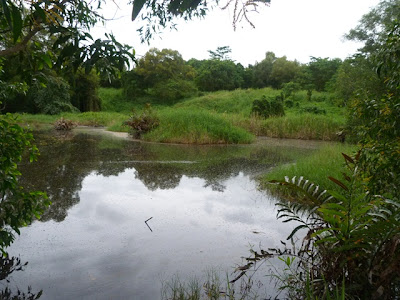By Gloria Seow, Education Group Chairperson
Photos by Lena Chow
Kids and their parents crowded around Uncle Alan as he guided us on Lorong Halus’ exciting birdlife.
NSS Kids had an eventful outing to Lorong Halus Wetland to take in its riverine and grassland birdlife. This took place on 11 December 2011, led by none other than Bird Group Chairperson Alan Owyong.
Lorong Halus, a former rubbish dump, now sits next to Singapore’s 17th and newest reservoir – the Serangoon Reservoir (previously known as the Serangoon River). How does national water agency PUB purify the run-offs that flow through the old dump into the reservoir? It built Lorong Halus Wetland. Opened in March 2011, the wetland comprises a series of holding ponds with plenty of water plants that filter and absorb pollutants from the water. Long before the current wetland came to be, birders have been visiting Lorong Halus for its plentiful birdlife. Its claim to fame is its Grebe pond. Here, our rare resident, the duck-like Little Grebe has been living and breeding for years.
A dirt path led us towards the Grebe pond. Along the way, we spotted grassland birds such as munias.
We met at the newly-built Visitor Centre and took a stroll to the scenic bridge that spans the Serangoon Reservoir. By simply standing on the bridge alone, we recorded close to 10 species of birds. We quickly saw our first avian star, the White-throated Kingfisher perched in a nearby tree. The keen eyes of 11-year old De Xuan Tranter picked up a Common Kingfisher out hunting on a faraway buoy. Auntie Gloria then found a Striated Heron that blended perfectly with the vegetation that lined the river bank. It stood stock still, waiting to spear its fishy prey with its lethal beak. Uncle Hang Chong and Uncle Kum Sang helped scope the birds spotted, while Auntie Lena and Uncle Timothy busied themselves snapping photos and finding more birds.
The bridge across Serangoon Reservoir was a good vantage point to spot birds.
Uncle Alan was the jovial Santa Claus, giving out bookmarks to kids who answered his pop quizzes correctly. He pointed out the Grey Heron, one of Singapore’s largest birds that live around our coastal waters. Later on, we found 23 of these biggies perched on a long row of buoys that snaked across the breadth of the river. While still on the bridge, two raptors soared by. The majestic White-bellied Sea Eagle drew gasps of wonderment, followed by three Black Bazas, decked in their black-and-white striped belly feathers. Lots of Pacific Swallows circled the skies. Some of them afforded us good views through the scope as they landed on buoys and trees. A good number of swiftlets (Germain’s and Black-nest) also patrolled the air space above us, hawking constantly for flying insects. All this while, Uncle Alan flashed bird photos from the accordion-like compact publication ‘A Field Guide to the Birds of Singapore’. This guide features the commoner 106 of the 370 odd species that have been recorded in Singapore. It is available for just $5 at the NSS Office (members only) or $10 in bookstores.
Uncle Alan engaged the kids with bird photos and birdy bookmarks as quiz prizes.
We also binoculared the Little Egret, the Common Sandpiper and White-winged Tern. Moving inland, we caught sight of several Scaly-breasted Munias feeding on grass seeds, as well as commoners such as the Eurasian Tree Sparrow, White-vented Myna, Common Myna and Spotted Dove. Before the rains descended, we squeezed in one last stop, the Grebe pond itself. We found a single Little Grebe warming a nest made of reeds and water plants, while another was merrily swimming and diving for food. Satisfied, we happily trooped back to the Visitor Centre where Uncle Alan had in store a barrage of birdy questions with accompanying bookmark prizes.
This pastoral pond is home to the Little Grebe.





No comments:
Post a Comment